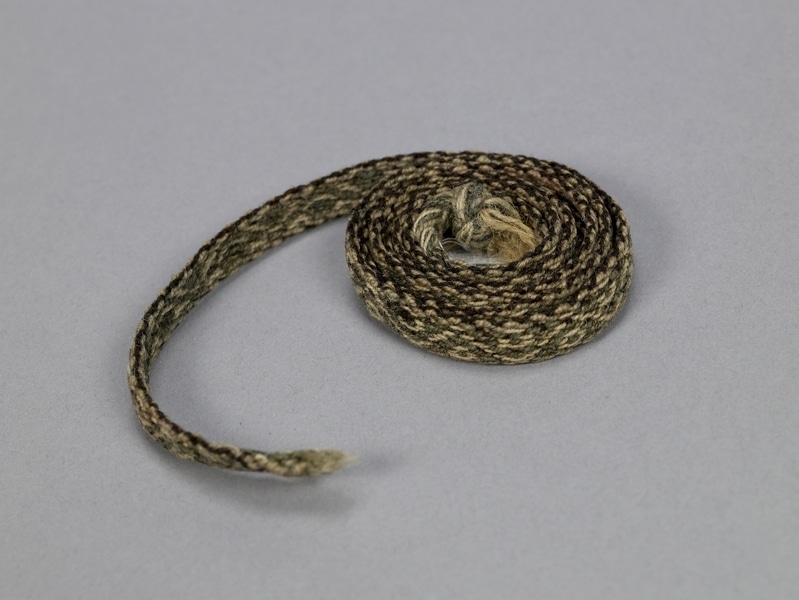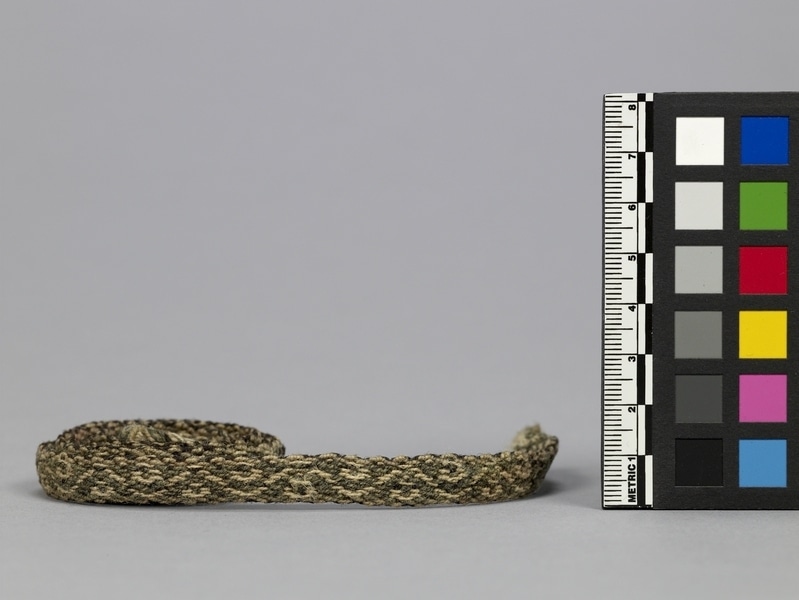Belt Item Number: Sf994 from the MOA: University of British Columbia


Description
Belt composed of a narrow warp-faced band with a grey-greenand off-white zigzag pattern running the length. Lenticular shapes fill the spaces on either side of the zigzag with a black border running along the edges. The unwoven warps at one end are braided and knotted. A tuft of light brown yarns are caught in the knot.
History Of Use
Warp-faced fabrics with three or four selvedges are woven by women on the indigenous style loom, a staked-out horizontal ground loom, or an adjustable tension (body) loom. The technique and structure have pre-Conquest antecedents, and as in ancient times, the fabrics are used in their rectangular form without cutting or shaping. Ênarrow bands have a number of miscellaneous uses as ties and straps. They are also used to swaddle babies of both sexes to the age of about 3 months. Used to hold the swaddling cloth in place by criss-crossing 2 or 3 times as the ends of the band wrap around the baby's body.
Narrative
Made by Valeria Yucra Huatta, a young unmarried woman. Used to hold swaddling cloths in place on a young baby.
Specific Techniques
Yarns are z=spun and 2 ply s. The fibre is animal hair, probably sheep's wool. The weave structure is a complementary warp weave structure and the weave is double-faced. One end of the band is finished in a 3-strand braid using grouped warps as single elements then ended with an overhand knot. Loom-shaped.
Cultural Context
swaddling
Item History
- Made by Valeria Yucra Huatta (Maker) in Taquile, Puno, Peru before 1984
- Collected by Elizabeth L. Johnson during 1984
- Owned by Elizabeth L. Johnson before June 13, 1984
- Received from Elizabeth L. Johnson (Seller) and Museum of Anthropology Shop Volunteers (Funding source) on June 13, 1984
What
- Name
- Belt
- Identification Number
- Sf994
- Type of Item
- belt
- Material
- wool fibre and alpaca wool fibre
- Manufacturing Technique
- woven, braided, plied and spun
- Overall
- height 0.9 cm, width 99.5 cm
Who
- Culture
- Quechua
- Creator
- Valeria Yucra Huatta (Maker)
- Field Collector
- Elizabeth L. Johnson
- Previous Owner
- Elizabeth L. Johnson
- Received from
- Elizabeth L. Johnson (Seller) and Museum of Anthropology Shop Volunteers (Funding source)
Where
- Holding Institution
- MOA: University of British Columbia
- Made in
- Taquile, Puno, Peru
When
- Creation Date
- before 1984
- Collection Date
- during 1984
- Ownership Date
- before June 13, 1984
- Acquisition Date
- on June 13, 1984
Other
- Item Classes
- textiles
- Condition
- fair
- Accession Number
- 0992/0017